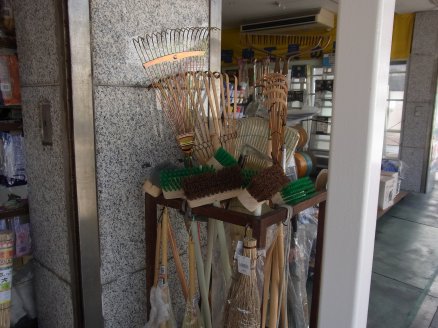
11月に日本各地の神社で「酉の市」と呼ばれるお祭りが開催されます。
In
November, shrines across Japan hold festivals called “Tori-no-Ichi 酉の市”.
Many
people come to buy bamboo “Kumade 熊手 Ornamental rake”
adorned with many models of the objects of great value.
A common
“Kumade Rake” is a broom with some thin bamboo that were bent like a bear’s hands
in a fan shape at the edge of a long bamboo handle.
“Kumade
Rake” is usually used to collect fallen leaves in the yard and grains in the
fields.

Eventually,
“Kumade Rake” came to “Kumade Ornamental rake” that symbolize the wish to rake
in good fortune as well.
People
thought that “Kumade Ornamental rake” would catch “Fuku 福 luck” as the eagles claw hold of the preys.
“Kumade
Ornamental rake” are also considered as important “Omamori お守り Amulets” that bring success in business.
It is
covered with pine needles, cherry blossoms, golden coins, rice baskets, cranes,
turtles, the seven gods of luck, and perhaps a pudgy white smiling face.
In the local
shops and restaurants, there is probably “Kumade Ornamental rake” hanging on
the wall.
This “Kumade
Ornamental rake” is as indispensable an object to any “Sushi 寿司”, “Unagi 鰻 Eel”, or noodle shop, nightclub,
grocery, or bookstore, as the ubiquitous welcoming cat.
After the cat welcomes a customer in, “Kumade
Ornamental rake” helps pull in his money.
Tokyoites
who want to have a financially successful year will visit “Tori-no-Ichi
Every
year, it is said that buying things a little larger, a bit more ornate, and a little
more expensive than the previous year will lead to prosperous business.
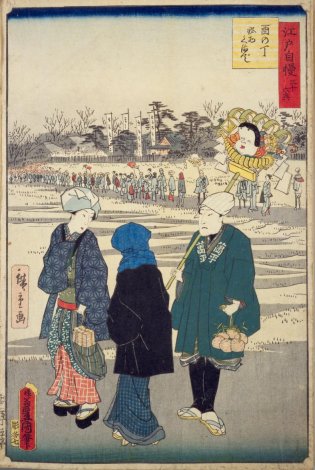 「江戸自慢三十六興 酉の市銘物くまで」 広重、豊国 国立国会図書館 所蔵
「江戸自慢三十六興 酉の市銘物くまで」 広重、豊国 国立国会図書館 所蔵
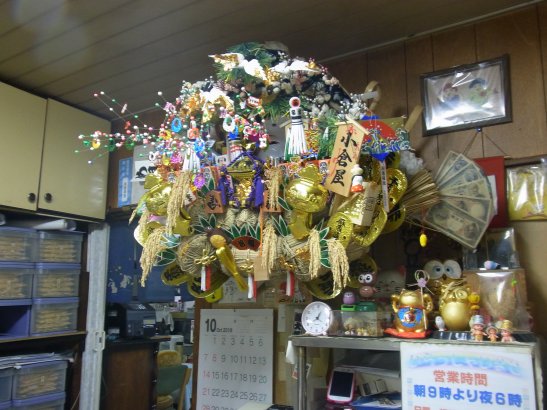
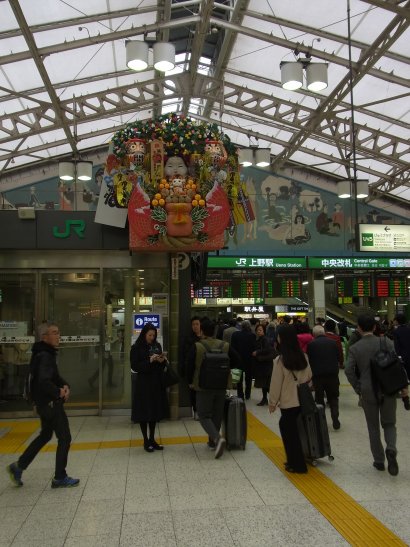
かつて、新年の様々な「最初」に注目することが、人気の娯楽でした。
In the
past, paying attention to all sorts of “firsts” of the year was a popular
pastime.
There
was “Waka-mizu 若水 First drawing of water”, “Kado-ake 門明け First visit to the head of the family’s home”, “Hatsu-buro 初風呂 First bath”, “Haki-zome 掃き初め First sweeping
of the house”, and more.
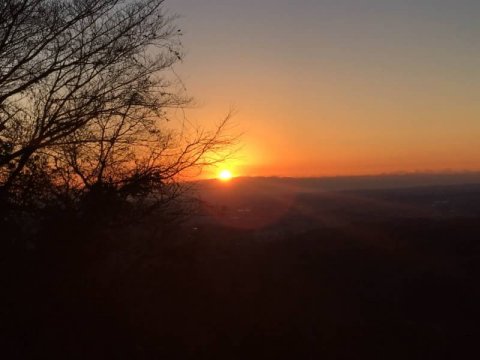 First sun rize from Mt.Takao: photo by Suzuki Kouichi
First sun rize from Mt.Takao: photo by Suzuki Kouichi
「初夢(最初の夢)」は、特に将来の重要な前兆です。
“Hatsu-yume
初夢
First dream” were especially important signs of the future.
そのため、これからの一年の幸運を告げる夢を確実に見るために事前に準備することがかつての慣習でした。
And it
was once customary to prepare ahead of time to ensure a dream that would tell
one’s fortune for the coming year.
According
to tradition, on New Year’s Eve (or the first or second the evening of
January), street vendors vended cheap woodblock prints depicted “Takara-bune
That
“Takara-bune Treasure ship” is loaded
with “O-takara お宝 Treasure” and “Shichifuku-jin 七福神 the seven gods of luck”.
これらの印刷物は何回も使うように作られたのではなく、一晩だけ枕の下に置かれます。
These
prints were not made to last a long time, but rather they were to be placed
under the pillow for a single night.
それらは「吉夢」を見るための手段でした。
They
were the means of obtaining “Kihci-mu 吉夢 Happy dream”.
翌朝には、夢を見た人のその年の運命が決まります。
By the next morning, the dreamer’s fate for the year would be set.
帆には「宝」の文字があり、船の周りには独特の「回文」が書かれています。
On the
sail is the character for “Takara 宝Treasure”, and
somewhere around the ship is a peculiar “Kaibun 回文 Palindrome”.
それは、「なかきよの とおのねふりの みなめさめ なみのりふねの おとのよきかな(長き夜の 遠の眠りの 皆目覚め 波乗り船の 音の良きかな)」です。
It is “NaKaKiYoNo
ToONoNeFuRiNo MiNaMeSaMe NaMiNoRiFuNeNo OToNoYoKiKaNa 長き夜の遠の眠りの皆目覚め波乗り船の音の良きかな”
When
everyone wakes up at dawn there is the lovely sound of waves and smooth sailing
ahead.
枕の下に「宝船」の絵を置き、「吉夢」を導く習慣は、「室町時代(1336-1568)」頃に貴族のために始まりました。
The
custom of putting a picture of “Takara-bune Treasure ship” under the pillow to
induce “Kichi-mu Happy dream” started for the nobilities around the “Muromachi-jidai
室町時代
Period (1336-1568)”.
「江戸時代」には庶民に広まりました。
It
spread to the commoners during “Edo-jidai 江戸時代 Period
(1603-1868)”.
それらの絵は、「関西」では神社やお寺で売られ、江戸では街頭で売られました。
Their
prints were sold at shrines and temples in “Kansai 関西 Region” and they were sold by street vendors in Edo.
もし、見た夢が悪かった場合、その夢は版画と共に川に投げ捨てられました。
If the
dream was a bad one, it was tossed away into a river along with the print.
The best
place to sell these print for “Kichi-mu Happy dream” was “Yūkaku 遊郭 Red-light district”.
花魁とそのお客は、「吉夢」のために、高額のチップと共に代金を払ってくれました。
“Oiran 花魁 Coutesan” and their patrons often paid money for “Kichi-mu Happy
dream” with a large tip.
Today
you can get a copy of the “Takara-bune Treasure ship” at the temples featuring
one of “Shichi-fukujin 七福神Seven lucky gods
(Benzaiten, Daikokuten, Ebisu, Bishamonten, Jurōjin, Hotei, or Fukurokuju)”.
It is
said that the best “Hatsu-yume First dream” are “First is Mt. Fuji, second is Hawk
and third is Eggplant”.
この夢の意味に関して、多くの説があります。
There are
many theories about the meanings of this dream.
There is
a theory that they was chosen as connection with “Takagawa Ieyasu 徳川家康”, who became “Tenka-bito 天下人 Person who conquer
the whole country”.
Mt. Fuji
is in “Suruga 駿河 (Shizuoka Prefecture)” where the place remembered
in connection with him, and his favorite pastime were “Taka-gari 鷹狩 Falconry” and favorite food is “Nasu 茄子 Eggplant”.
多くの説の中で、最も興味深いのは、これらのシンボルを「天下三大仇討ち」に結びつけた説です。
Among
the many theories about the meanings of this dreams, the most interesting is
the one connecting these symbols with “Tenka sandai adauchi 天下三大仇討ち The most famous three revenges in Japan”.
These “Adauchi
仇討ち Revenge” are the popular programs at Kabuki theater.
「江戸時代」の「歌舞伎」は、間違いなく流行に大きな影響を与えるトレンドセッターでした。
In
“Edo-jidai Period”, “Kabuki” theater was unquestionably a trendsetter for the
commoners.
長年に渡って切望した復讐を遂げた3つの物語が、「吉夢」が結びついたと考えられます。
It is thought
that “Kichi-mu Happy dream” was linked to three stories that finally realized
long-sought revenges by the avengers.
These
are “Soga –mono 曽我物 Program that feature the revenge by
Soga brothers”, “Ako-jiken 赤穂事件 The incident by
the masterless samurai (Roshi) of Ako clam”, and “lga-goe no adauchi 伊賀越えの仇討 The revenge at the Iga Pass”.
“Soga Kyōdai
曽我兄弟
Brothers” fulfilled his father ’s “Ada-uchi Revenge” at the
foot of Mt. Fuji.
「赤穂事件」で切腹させられた「浅野内匠頭」の「家紋」が鷹の羽です。
The “Kamon
家紋 Crest” of “Asanotakumi no kami 浅野内匠頭 Daimyo”, who did “Seppuku 切腹 Hara-kiri” in the
“Ako Incident”, is the wing of a hawk.
And the
special product of “Iga 伊賀 Region” is eggplant.
「招き猫」は、前足で人を招く形をした猫の置物で、商売繁盛の「縁起物」です。
“Maneki-neko
Cats have long been considered good animals
to exterminate rats that eat crops and silkworms.
Cats
raising the right forepaw invite "money", and cats raising the left forepaw
are said to invite people (customers).
“Hikone-han
彦根藩Clan” second feudal lord “Ii Naotaka 井伊直孝” came back from “Taka-gari 鷹狩 Falconry” and there
was a white cat beckoning in front of the temple.
After taking a break at the temple, it was
a sudden thunderstorm.
And he
was impressed by the talk of “Oshō
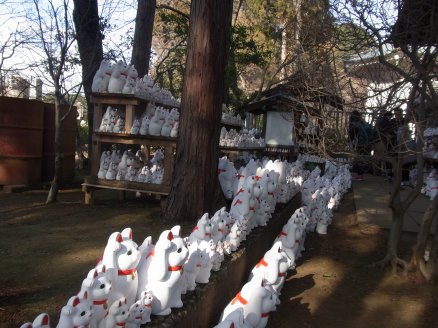
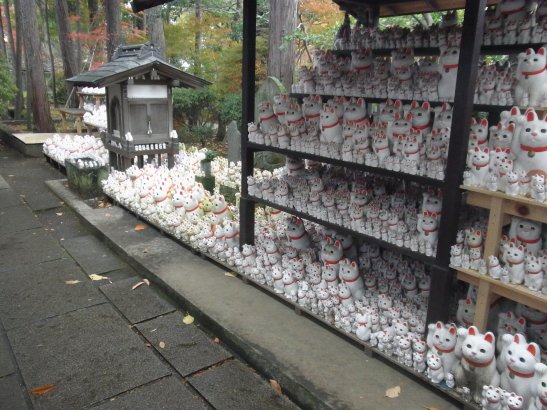
“Imado-jinja
今戸神社 Shrine” in Taito-ku is also said to be the birthplace of “Maneki-neko
Luck”.
In the “Edo-jidai
江戸時代
Period”, an old woman had released a cat because of poverty.
One
night, a cat stood on the old woman's bedside in her dream and told her that “If
you make dolls like me, fortune will be given”.
She made
the cat dolls at “Imado-yaki
It is
said that the cat dolls have since become very popular.
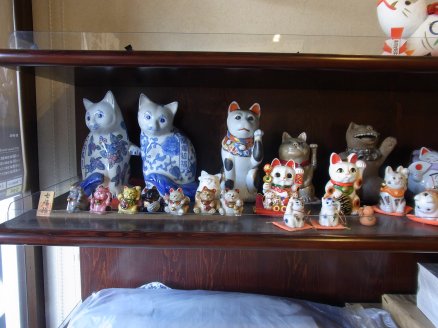
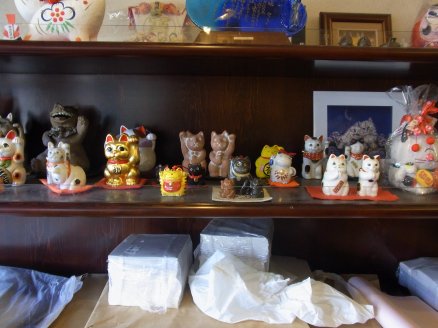
羽根突きというゲームは、羽子板と呼ばれる精巧に装飾された櫂のような道具を使います。15世紀から宮廷内で楽しまれたことが知られています。
The game of hanetsuki (battledore), played with elaborate paddles called
hagoita, has been in existence since the fifteensh century, when it was
played at the Imperial Court.
多くの点でバドミントンと似ていますが、正月休みに女性だけが楽しむゲームとして伝えられてきました。
In many ways similar to badminton, this game is traditionally reserved
for females and played only during the New Year's holidays.
毎年12月17日から同19日まで浅草の浅草寺の境内で開催される羽子板市は、江戸時代に始まりました。
Nowadays one has to look long and hard to fine a New Year's tourney even though the decorative paddles, the hagoita, are the focus of a huge, lively festival every December at Tokyo's Asakusa Kannon temple grounds.
考えられる形と大きさの羽子板が、数えきれない小さな出店の天井や側面に飾られます。
Paddles of every conceivable shape and size are splendidly hung from the
ceilings and sides of innumrable small festival stalls.
通常、60を超える出店があり、多くは商売人が暖を取れるように畳と火鉢が据えつけられています。
There are usually more than sixty stalls, many of which are fitted out
with tatami and charcoal warmers for the merchants' comfort.
寒空の下、人々でごった返し、食べたり、飲んだり、粋で指先を温めたり、足をゆすったりしています。
Crowds mill about, eating, drinking, blowing on fingers, and stamping their feet in the cold.
威勢のいい掛け声が広がり、羽子板が売れるごとに、伝統的な手拍子が聞こえます。
Boisterous sales pitches ring out; the ritual clapping sequence of 3-3-3-1 is heard at each purchase.
手締めの拍数の「3回・3回・3回・1回」は3回の拍を3回繰り返すことで九になり、もう1回手を打つと九に点が打たれて「丸」になり「丸く納まる」の意味になるからとも言われています。
江戸時代に入ると、ますます手が込んだものになりました。歌舞伎役者などをかたどった押絵羽子板が流行しました。その年の人気役者の当たり狂言や舞台姿が求められるようになり、すっかりゲームから離れたものになりました。
Since the Edo Period, hagoita have become increasingly elaborate, until
gradually they have taken on a life of their own, quite apart from the
game.
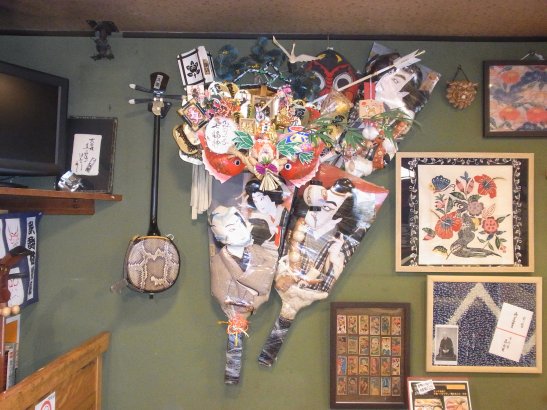
羽子板でつく羽がついた黒くて堅い玉は“むくろじ”という大木の種で、邪気を跳ね返し、「子供が患わない」という意味が込められて「無患子」と書き、女の子の無病息災の願いが込められています。